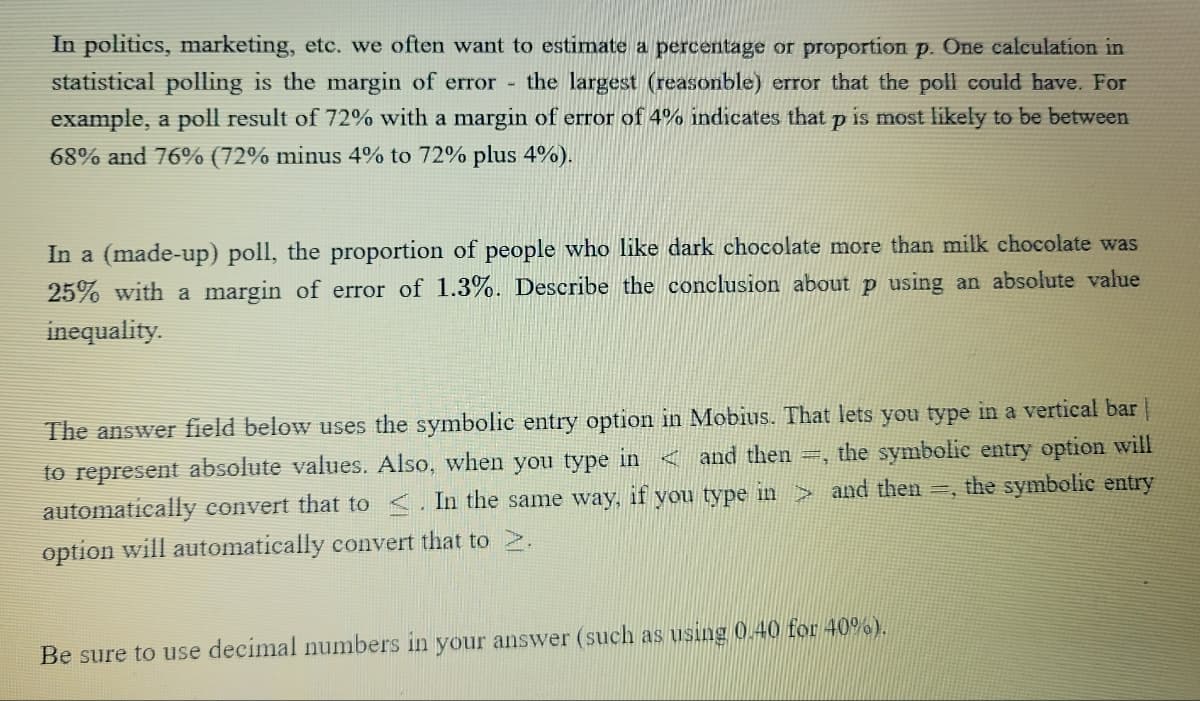In politics, marketing, etc. we often want to estimate a percentage or proportion p. One calculation in statistical polling is the margin of error - the largest (reasonble) error that the poll could have. For example, a poll result of 72% with a margin of error of 4% indicates that p is most likely to be between 68% and 76% (72% minus 4% to 72% plus 4%). In a (made-up) poll, the proportion of people who like dark chocolate more than milk chocolate was 25% with a margin of error of 1.3%. Describe the conclusion about p using an absolute value inequality. The answer field below uses the symbolic entry option in Mobius. That lets you type in a vertical bar to represent absolute values. Also, when you type in and then =, the symbolic entry option will automatically convert that to <. In the same way, if you type in and then, the symbolic entry option will automatically convert that to >. Be sure to use decimal numbers in your answer (such as using 0.40 for 40%).
In politics, marketing, etc. we often want to estimate a percentage or proportion p. One calculation in statistical polling is the margin of error - the largest (reasonble) error that the poll could have. For example, a poll result of 72% with a margin of error of 4% indicates that p is most likely to be between 68% and 76% (72% minus 4% to 72% plus 4%). In a (made-up) poll, the proportion of people who like dark chocolate more than milk chocolate was 25% with a margin of error of 1.3%. Describe the conclusion about p using an absolute value inequality. The answer field below uses the symbolic entry option in Mobius. That lets you type in a vertical bar to represent absolute values. Also, when you type in and then =, the symbolic entry option will automatically convert that to <. In the same way, if you type in and then, the symbolic entry option will automatically convert that to >. Be sure to use decimal numbers in your answer (such as using 0.40 for 40%).
Glencoe Algebra 1, Student Edition, 9780079039897, 0079039898, 2018
18th Edition
ISBN:9780079039897
Author:Carter
Publisher:Carter
Chapter10: Statistics
Section10.6: Summarizing Categorical Data
Problem 10CYU
Related questions
Question

Transcribed Image Text:In politics, marketing, etc. we often want to estimate a percentage or proportion p. One calculation in
statistical polling is the margin of error - the largest (reasonble) error that the poll could have. For
example, a poll result of 72% with a margin of error of 4% indicates that p is most likely to be between
68% and 76% (72% minus 4% to 72% plus 4%).
In a (made-up) poll, the proportion of people who like dark chocolate more than milk chocolate was
25% with a margin of error of 1.3%. Describe the conclusion about p using an absolute value
inequality.
The answer field below uses the symbolic entry option in Mobius. That lets you type in a vertical bar |
to represent absolute values. Also, when you type in and then =, the symbolic entry option will
automatically convert that to <. In the same way, if you type in and then, the symbolic entry
option will automatically convert that to 2.
Be sure to use decimal numbers in your answer (such as using 0.40 for 40%).
Expert Solution
This question has been solved!
Explore an expertly crafted, step-by-step solution for a thorough understanding of key concepts.
This is a popular solution!
Trending now
This is a popular solution!
Step by step
Solved in 3 steps

Recommended textbooks for you

Glencoe Algebra 1, Student Edition, 9780079039897…
Algebra
ISBN:
9780079039897
Author:
Carter
Publisher:
McGraw Hill

Holt Mcdougal Larson Pre-algebra: Student Edition…
Algebra
ISBN:
9780547587776
Author:
HOLT MCDOUGAL
Publisher:
HOLT MCDOUGAL

Glencoe Algebra 1, Student Edition, 9780079039897…
Algebra
ISBN:
9780079039897
Author:
Carter
Publisher:
McGraw Hill

Holt Mcdougal Larson Pre-algebra: Student Edition…
Algebra
ISBN:
9780547587776
Author:
HOLT MCDOUGAL
Publisher:
HOLT MCDOUGAL